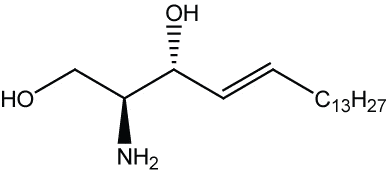Classifying lipids is really easy. In short, lipids are hydrophobic or “water fearing/hating” biomolecules.
Here are some common types of lipids:
Fatty Acids:
Fatty Acid Structure: a carboxylic acid with a long hydrocarbon chain with even carbons (sometimes odd)
Example of a Fatty Acid:
Palmitic acid:
Palmitoleic acid
Difference between Unsaturated and Saturated Fatty Acid:
- Unsaturated fatty acids contain a double bond in the structure (see palmitoleic acid above)
- Saturated fatty acids do not contain a double bond and instead have a long hydrocarbon chain
Effects of Melting Point on Fatty Acids:
- Saturated fatty acids are solids at room temperature
- Examples:
- Lauric acid
- Myristic acid
- Palmitic acid
- Examples:
- Unsaturated fatty acids are liquid at room temperature
- Examples
- Palmitoleic acid
- Oleic acid
- EPA and DHA (commonly found in krill oil)
- Unsaturated fatty acids almost always have a cis configuration at the double bond.
- Double bond makes the structure much more rigid
- Have a lower melting point than saturated fats
- Examples
Note: Increasing hydrocarbon chain increases the melting point of saturated fatty acids.
Acylglycerols or Glycerides:
A glycerol (or acylglycerol) contains 1 glycerol group and 1 or more fatty acid groups attached.
Some basic nomenclature:
- glycerol + 1 fatty acid = monoacylglycerol
- glycerol + 2 fatty acids = diacylglycerol
- glycerol + 3 fatty acids = triacylglyerol or triglyceride (FAT)
Esterification of Glycerol:
General Glycerol Reaction Scheme:
Alcohol + Carboxylic Acid <—>(H+) <—> Ester + Water
For example:Triglycerol

Source: Wikipedia
Functions of Triglycerol:
- Long term energy storage
- Stored in adipose tissue
- Release energy upon oxidation
- 6x the energy for an equal weight of hydrated glycogen
Glycerophospholids:
- Also known as phosphoglycerides
- Major lipid in cell membranes
- Comprised of a Glycerol-3-phosphate + 2 fatty acids and a polar R3group (view image below)
- R1 is usually a saturated fatty acid
- R2 is usually an unsaturated fatty acid
- R3 is a polar group (usually)

Sphingolipids:
- Contain the alcohol sphingosine instead of glycerol as the backbone
- One fatty acid connected via an amide linkage to a sphingosine
- A single fatty acid chain attached is called a ceramide
- The sphinigolipid may contain one phosphate/alcohol group via an inorganic ester linkage (also known as sphingophospholipids)
- The sphingolipid may also contain one sugar via a clycosidic linkage (glycosphingolipid)

A sphingosine
Functions of Sphingolipids:
- Sphingolipids are important components of the membrane, especially in the nervous system.
- Responsible for protecting nerve cells on myelin sheath
- Examples:
- Sphingomyelin
- Cerebroside
- Gangliosides
Steroids:
Steroids are all derivatives of cyclopentanoperhydrophenanthrene, which is this thing below:
Most abundant steroid is cholesterol, which is a major component of all animal cell membranes. Cholersterol is also used as a precursor for synthesis of all other steroid.
Steroid are also sometimes hormones:
Example:
- Glucocorticoids
- Affect metabolism and inflammatory response (cortisol)
- Mineralcorticoids
- Affect salt and water excretion in kidneys (aldosterone)
- Androgens/Estrogens
- Affect sexual development and function (testosterone and estradiol)
Fat Soluable Vitamins:
- Vitamin D
- Comes from the hormone ergosterol
- Regulates Ca2+ metabolism
- Vitamin A (retinol)
- From plant beta-carotene
- Retinal = eye photoreceptor
- Vitamin K
- From plants and bacteria
- Important in blood clotting
- Vitamin E
- An antioxidant in cell membranes